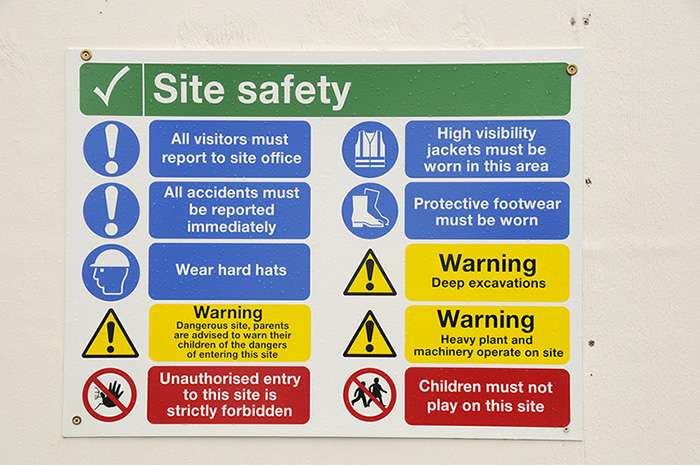

Acceptable signage is a important part of controlling dangers inside the office, with shade taking part in a big position within the identification of hazards.
The AS 1318-1985 SAA Industrial Security Coloration Code defines using purple, yellow, inexperienced and blue for marking bodily hazards and finding explicit gear.
Defining using colours is most vital in producing consistency throughout workplaces, thus creating an expectation of their use for employees.
Nonetheless colours also can have a psychological and behavioral affect on individuals, making some colours extra suited to explicit makes use of than others.
Crimson:
In accordance with the Security Coloration Code, purple needs to be used to point hazard, find fireplace combating gear and establish cease buttons and emergency cease controls.
White lettering, stripes or edging could also be added, nevertheless purple needs to be the essential or background shade on the signal.
Crimson and hazard:
A 2009 examine discovered that purple was related to failure and damaging phrases, whereas a 2014 examine discovered a powerful hyperlink between the colour purple and an implicit affiliation with hazard.
One other analysis staff studied the impact of purple in achievement contexts, discovering that it impaired efficiency and prompted avoidance motivation as a substitute.
In different phrases, the colour led individuals to make decisions primarily based on avoiding the potential of failure or damaging penalties, making it a wonderful selection for indicators warning of hazard.
Yellow:
Yellow, both alone or with black markings, is used to spotlight areas the place warning needs to be used, or the place radiation hazards exist.
Yellow and warning:
In darkness, yellow is probably the most seen shade from a distance and the second most seen shade through the day, after inexperienced.
Shades of yellow are the least nice colours to the attention, whether or not it’s the straight shade or green-yellow/red-yellow variations.
Moreover, green-yellow prompts probably the most physiological stimulation, in addition to the strongest dominance emotions, alongside straight yellow.
And whereas red-green color-blindness is comparatively frequent, notably amongst males, blue-yellow color-blindness is extraordinarily uncommon.
Given yellow and its numerous offshoots might be worrying and an eyesore, in addition to seen to nearly all of individuals with out bother, it is a logical option to denote areas the place heightened alertness and warning are essential.
Greens:
Inexperienced, used with white, signifies the situation of security and first help gear, apart from fireplace combating gear.
Inexperienced and well-being:
In addition to being extremely seen, inexperienced can be related to success phrases and a chilled impact, with inexperienced and blue rooms discovered to be much less anxiety-provoking than purple and yellow rooms in a healthcare setting.
Inexperienced has been linked with medication for the final century, starting with an American surgeon, who created a inexperienced working theater in 1914 to reap the benefits of its distinction with purple, permitting him to view the feel and particulars of wounds extra simply.
Across the similar time, “shade remedy” additionally launched inexperienced to hospitals, associating it with relaxation and contentment. Within the years that adopted, numerous architects and directors advocated for using inexperienced in medical settings till it turned a significant image of hospitals.
Given its traditionally sturdy affiliation with well-being and healthcare, inexperienced signage for security and first help gear will not be a stunning selection.
Blue:
Blue is used as the bottom or background shade in signage that denotes necessary directions to be adopted, or data of a common nature. Lettering should be in white.
Blue and trustworthiness:
Blue is often used within the company world in logos and branding, and is perceived as reliable, high-quality and reliable.
Blue gentle has additionally been proven to extend alertness and efficiency in attention-based duties, whereas blue rooms diminished anxiousness in hospitals.
Consequently, when utilized in signage, many individuals may need an instinctive belief or confidence within the data or directions being conveyed.
Whereas colours have been proven in analysis to lead to explicit psychological or behavioral responses, people should still have completely different responses primarily based on their very own backgrounds.
In consequence, different nations could select to make use of completely different colours for various signage makes use of primarily based on their very own cultural perceptions.
The publish Coloration for marking bodily hazards: SAA Industrial Security Coloration Code appeared first on Paramount Security Merchandise.
